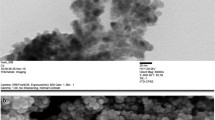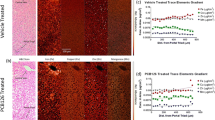Summary
In livers of rats exposed to varying doses of CdCl2 80–90% of the cadmium content present in the fresh tissue is retained if these livers are fixed with a neutral or acid formalin fixative.
Cadmium assays during different stages of the staining procedure for protein bound disulphides show the ability of this staining to demonstrate cadmium thiolate clusters next to disulphides. The methods described may also be useful in gaining more insight in the mechanism involved in fixation and staining procedure of some other metals.
Similar content being viewed by others
References
Berry MN, Friend DS (1969) High yield preparation of isolated rat liver parenchymal cells. A biochemical and fine structural study. J Cell Biol 43:506–520
Cherian MG, Onosaka S (1982) Biliary excretion of cadmium in rat. V. Effects of structurally related mercaptans on chelation of cadmium from metallothionein. J Toxicol Environ Health 9:389–399
Haywood S (1985) Copper toxicoses and tolerance in the rat. I. Changes in copper content of the liver and the kidney. J Pathol 145:149–158
Lerch H (1980) Copper metallothionein, a copper binding protein from Neurospora crassa. Nature 284:368–370
Meulenaar H, van den Hamer CJA, van den Ingh TSGAM, Stolk TMW (1985) The effect of pH and lysosomal extract on rat liver metallothionein. Biol Trace Elem Res 7:49–54
Morselt AFW, Broeckaert D, Jongstra-Spaapen EJ, Copius Peereboom-Stegeman JHJ (1984) Histochemical changes in protein disulphide bonds in rat liver and kidney after chronic cadmium administration and the possible relation to metallothionein. Arch Toxicol 55:155–160
Morselt AFW, van den Hamer CJA, Prinsen L, Jongstra-Spaapen EJ, Copius Peereboom-Stegeman JHJ, Boschj KS (1985) Large increase in disulphide bonds containing cytosol proteins after chronic cadmium administration, estimated in isolated rat liver cells. Histochemistry 83:227–229
Otvos JD, Armitage IM (1980) Structure of the metal clusters in rabbit metallothionein. Proc Natl Acad Sci USA 77:7094–7098
Sato M, Nagai Y (1980) Mode of existence of cadmium in rat liver and kidney after prolonged subcutaneous administration. Toxicol Appl Pharmacol 54:90–99
Shinobu LA, Jones SG, Jones MM (1983) Mobilization of aged cadmium deposits by dithiocarbamates. Arch Toxicol 54:235–242
Sumi Y, Koyama Y, Muraki T, Suzuki T (1984) The staining properties of thiazolylazoalkylaminophenol derivates in histochemical staining of cadmium. Basic Appl Histochem 28:137–142
Suzuki KT, Yaguchi K, Okuki R, Nishikawa M, Yamaha YK (1983) Extent of cadmium accumulation and its effects on essential metals in liver, kidney and body fluids. J Toxicol Environ Health 11:713–726
Tanke HJ (1982) Cytochemical staining of DNA and RNA for analytical cytology. Dissertation Leiden
Tas J (1977) The Alcian blue and combined Alcian blue Safranine 0 staining of glycosaminoglycans studied in a model system and in mast cells. Histochem J 9:205–230
Author information
Authors and Affiliations
Rights and permissions
About this article
Cite this article
Morselt, A.F.W., van Straalen, N.M. Histochemical staining of cadmium thiolate clusters in livers of rats treated chronically with cadmium. Histochemistry 84, 45–47 (1986). https://doi.org/10.1007/BF00493419
Accepted:
Issue Date:
DOI: https://doi.org/10.1007/BF00493419




